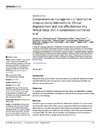Identificador persistente para citar o vincular este elemento:
https://accedacris.ulpgc.es/jspui/handle/10553/70074
| Título: | Comprehensive management of obstructive sleep apnea by telemedicine: clinical improvement and cost-effectiveness of a virtual sleep unit. A randomized controlled trial | Autores/as: | Lugo, Vera M. Garmendia, Onintza Suarez-Girón, Monique Torres, Marta Vázquez Polo, Francisco José Negrín Hernández, Miguel Ángel Moraleda, Anabel Roman, Mariana Puig, Marta Ruiz, Concepcion Egea, Carlos Masa, Juan F. Farré, Ramon Montserrat, Josep M. |
Clasificación UNESCO: | 530202 Modelos econométricos | Palabras clave: | Apnea Unidad del sueño Tratamiento Coste-beneficio Métodos estadísticos |
Fecha de publicación: | 2019 | Proyectos: | PI14/00416 PI17/01068 Catalan Society of Pneumology (SOCAP) |
Publicación seriada: | PLoS ONE | Resumen: | Introduction Obstructive sleep apnea (OSA) is a prevalent disease associated with significant morbidity and high healthcare costs. Information and communication technology could offer cost-effective management options. Objectives To evaluate an out-of-hospital Virtual Sleep Unit (VSU) based on telemedicine to manage all patients with suspected OSA, including those with and without continuous positive airway pressure (CPAP) therapy. Methods This was an open randomized controlled trial. Patients with suspected OSA were randomized to hospital routine (HR) or VSU groups to compare the clinical improvement and cost-effectiveness in a non-inferiority analysis. Improvement was assessed by changes in the Quebec Sleep Questionnaire (QSQ), EuroQol (EQ-5D and EQ-VAS), and Epworth Sleepiness Scale (ESS). The follow-up was 3 months. Cost-effectiveness was assessed by a Bayesian analysis based on quality-adjusted life-years (QALYs). Results The HR group (n: 92; 78% OSA, 57% CPAP) compared with the VSU group (n: 94; 83% OSA, 43% CPAP) showed: CPAP compliance was similar in both groups, the QSQ social interactions domain improved significantly more in the HR group whereas the EQ-VAS improved more in the VSU group. Total and OSA-related costs were lower in the VSU group than the HR. The Bayesian cost-effectiveness analysis showed that VSU was cost-effective for a wide range of willingness to pay for QALYs. Conclusions The VSU offered a cost-effective means of improving QALYs than HR. However, the assessment of its clinical improvement was influenced by the choice of the questionnaire; hence, additional measurements of clinical improvement are needed. Our findings indicate that VSU could help with the management of many patients, irrespective of CPAP use. | URI: | https://accedacris.ulpgc.es/handle/10553/70074 | ISSN: | 1932-6203 | DOI: | 10.1371/journal.pone.0224069 | Fuente: | PLoS ONE [ISSN 1932-6203], v. 14 (10), e0224069 |
| Colección: | Artículos |
Citas SCOPUSTM
47
actualizado el 08-jun-2025
Citas de WEB OF SCIENCETM
Citations
36
actualizado el 08-jun-2025
Visitas
112
actualizado el 04-may-2024
Descargas
119
actualizado el 04-may-2024
Google ScholarTM
Verifica
Altmetric
Comparte
Exporta metadatos
Los elementos en ULPGC accedaCRIS están protegidos por derechos de autor con todos los derechos reservados, a menos que se indique lo contrario.
